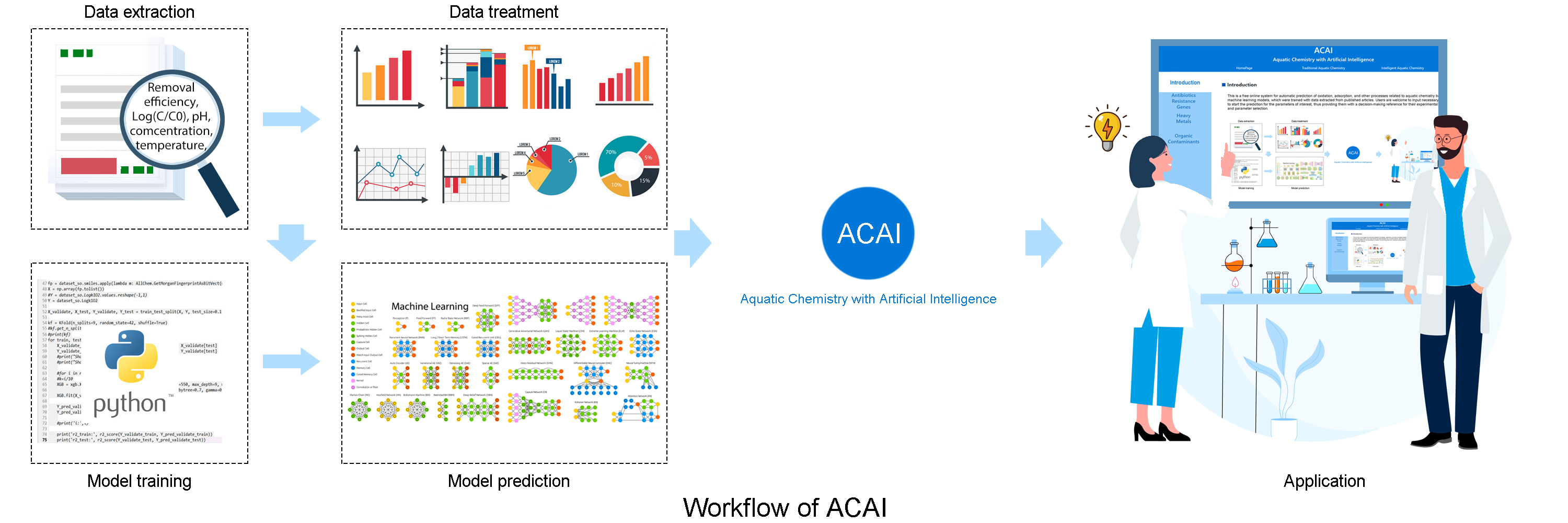ACAI
Aquatic Chemistry with Artificial Intelligence
■ Introduction
This is a free online system for automatic prediction of oxidation, adsorption, and other processes related to aquatic chemistry based on machine learning models, which were trained with data extracted from published articles. Users are welcome to input necessary variables to start the prediction for the parameters of interest, thus providing them with a decision-making reference for their experimental design and parameter selection.

■ Introduction
In this page, machine learning models were developed to predict the degradation and deactivation rates of ARGs by disinfection with chlorine, ultraviolet light, ozone, and hydrogen peroxide, based on data collected from the published papers. Users can predict the degradation rates of ARGs determined with qPCR technology and the deactivation rates of ARGs determined with transformation assay in the above disinfection processes following the prompts. More detailed information about the development of machine learning models is available in the following study.
Ruixing Huang, Chengxue Ma, Xiaoliu Huangfu. A framework predicting removal efficacy of antibiotic resistance genes during disinfection processes with machine learning.
■ ARG degradation prediction
■ ARG deactivation prediction
■ ARG degradation-deactivation tandem prediction
■ Introduction
In this page, machine learning models were developed to predict the environmental stability and UV inactivation of coronavirus, in particular, SARS-Cov-2. For the environmental stability of coronavirus, the decay of coronavirus titers in solutions and on surfaces over time at -20 to 100 °C can be predicted. For UV inactivation of coronavirus, the decay of coronavirus titers in solutions and on surfaces with UV dose at wavelengths of 222-413 nm can be predicted. More detailed information about the development of machine learning models is available in the following study. A framework predicting removal efficacy of antibiotic resistance genes during disinfection processes with machine learning.
Ruixing Huang, Chengxue Ma, Xiaoliu Huangfu. Preparing for the Next Pandemic: Predicting the Environmental Stability of Coronavirus with Machine Learning.
Ruixing Huang, Chengxue Ma, Xiaoliu Huangfu, Jun Ma. Preparing for the Next Pandemic: Predicting UV Inactivation of Coronaviruses with Machine Learning. Environ. Sci. Technol. 2023, 57, 13767−13777
■ Coronavirus environmental stability prediction
■ Coronavirus UV inactivation prediction
■ Introduction
This Python simulator for second rate constant was built based on MF-LightGBM and the MD-XGBoost models. On this page, descriptors (MF and MD) and radical types (chlorine radical, dichloro radical, bromine radical, and dibromo radical) are provided as input feature options. The reactivity of halogen radicals with aqueous organic pollutants can be rapidly predicted by entering the SMILES, pH and temperature.
■ Rate constant prediction
■ Introduction
This Python simulator enables the prediction of DBP formation in drinking water treatment, including total DBPs (THM4, DHAA3, THAA4, DBAN3, HK2) and individual DBPs (TCM, BDCM, CDBM, DCAA, TCAA, DBAA, DCAN, BCAN, 1,1-DCP, and 1,1,1-TCP). Users need to provide the DBP type, water quality parameters (DOC, UV254, SUVA, and Br_CONC), operational conditions (Method, Dose, pH, Temp, and Time), or/and the SMILES string (for individual DBPs) to get the predicted DBP level. More detailed information about the development of machine learning models is available in the following study.
Youheng Liang et.al, Machine learning-guided prediction of chlorinated/chloraminated disinfection by-product formation in drinking water treatment.